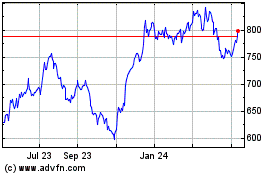Bond managers see it as a crucial ingredient of risk
management
By Matt Wirz
This article is being republished as part of our daily
reproduction of WSJ.com articles that also appeared in the U.S.
print edition of The Wall Street Journal (June 20, 2018).
Once a fringe concept, environmental-, social- and
governance-based investing has hit the mainstream.
A weighty-sounding proclamation by JPMorgan Chase & Co. in a
recent report trumpeting the arrival of so-called ESG investing may
sound like rhetoric from Occupy Wall Street: "Civil society is
calling on the financial-services industry to advance sustainable
development goals," the report said.
But the many banks, investment firms and financial-data
providers scrambling to roll out new ESG-branded products --
particularly in bond markets -- are also trying to get out a
less-lofty message. Investing by ethical and environmental
standards is no longer mainly about making the world a better
place, they say. It's about making more money by avoiding
losses.
"The driver has moved from an ethical and moral dimension to
'this makes for good risk management,' " says My-Linh Ngo, an ESG
analyst for BlueBay Asset Management, a London-based investment
firm that manages about $60 billion of bond portfolios. "This is
what gives you 'alpha,' " or better performance than a standardized
benchmark, she says.
Changing climate
Also referred to as socially responsible investing, or SRI, this
approach began in earnest in stock markets in the 1990s, but spread
to bonds in recent years, spurred in part by new European
regulations in response to climate change and the financial
crisis.
ESG also offers the promise of new revenue streams for
investment firms, banks and the data providers that cater to them.
Growing numbers of investors, especially millennials and European
institutions, want investment options that align with their ethical
and social goals -- excluding firearms manufacturers, for example,
or focusing on renewable-energy companies, analysts say.
Bond-buying giants, including BlackRock Inc., Pacific Investment
Management Co. and Franklin Templeton Investments, all unveiled ESG
initiatives in the past 18 months, as did midsize investment firms
Neuberger Berman Group LLC and Eaton Vance Corp. Bond-index
operators MSCI and Bloomberg Barclays have teamed up to offer an
ESG variant of the widely followed Bloomberg Barclays Aggregate
bond indexes.
Bond managers have always evaluated corporate governance and
social stability, among other more qualitative aspects of the
borrowers they lend to. The difference that the ESG lens brings is
an application of a systematic evaluation of such variables to
every investment decision.
For now, the frenzy to adopt ESG seems to have outpaced the
market capabilities to actually apply the concept. Indeed, there is
still no consensus on how to measure variables like social impact
and good governance or how to incorporate them in the decision to
buy or sell an individual bond. Credit-rating firms, the de facto
arbiters of bond quality for many institutions, don't yet provide
ESG ratings or guidance on how to do so.
"We have yet to see a credit-rating agency publish a transparent
and detailed methodology for analyzing ESG considerations as part
of their credit analysis," Jonathan Bailey, Neuberger Berman's head
of ESG investing, wrote in a research piece in December.
'Evolution' of investing
Ultimately, though, incorporation of ESG into debt markets is
inevitable, Mr. Bailey said in an interview. "It's just an
evolution of good investing."
That evolution got a big push about two years ago, when a
critical mass of European pension funds, insurers and other
institutional investors began only awarding new business to money
managers with ESG capabilities, analysts and fund managers say.
Investment firms that hadn't yet hired ESG specialists began doing
so and offering ESG bond funds.
As ESG spread in the financial industry, a new idea began to
take hold: Investors who incorporated environmental, social and
governance risks into their analysis of all bonds could reduce
losses over time.
Grading companies on executive governance, for example, could
help fund managers sidestep the bonds of a pharmaceutical company
ripe for regulatory blowback over price gouging or opioid pushing.
Measuring the political support of governments when comparing
countries with similar economic strength and debt profiles might
allow fund managers to pick which countries' bonds would perform
better over time.
Critics of such ideas say that while some ESG characteristics
can be quantified, allowing analysts to compare different bonds
uniformly, others are qualitative and poorly suited to such
evaluations. Variables like gender composition of a corporate board
and youth unemployment can easily be assigned a number, but the
susceptibility of a political leader to corruption or a
corporation's tolerance for dissent in middle management is harder
to reduce to a figure.
That challenge is an opportunity for analysts and fund managers
to prove their worth, says Franklin Templeton global bond fund
manager Michael Hasenstab, who in February announced the creation
of an index that quantifies ESG inputs and distills them into a
single numerical score. Franklin's country analysts feed the index
with data by assigning scores of 1 to 10 to a range of ESG
variables and forecasting how they expect the scores to change in
the medium term.
"What is really interesting is the one- to three-year forecast,"
Mr. Hasenstab says.
Franklin, which famously bought billions of dollars of bonds
from Ukraine and Hungary, is willing to invest heavily in countries
with poor social cohesion and governance as long as their scores
are expected to improve. It also may avoid stable countries where
ESG conditions are deteriorating. Mr. Hasenstab has sold or is
betting against bonds of Poland and the U.S, which have solid
scores but also have the highest potential to deteriorate among the
44 countries on Franklin's ESG index.
Mr. Wirz is a Wall Street Journal reporter in New York. He can
be reached at matt.wirz@wsj.com.
(END) Dow Jones Newswires
June 20, 2018 02:48 ET (06:48 GMT)
Copyright (c) 2018 Dow Jones & Company, Inc.
BlackRock (NYSE:BLK)
Historical Stock Chart
From Mar 2024 to Apr 2024

BlackRock (NYSE:BLK)
Historical Stock Chart
From Apr 2023 to Apr 2024
